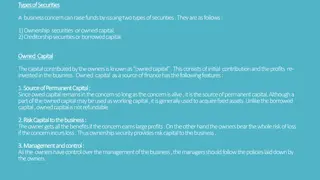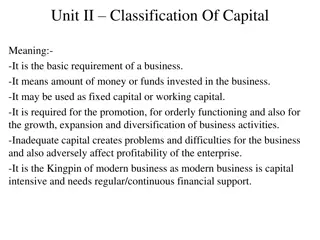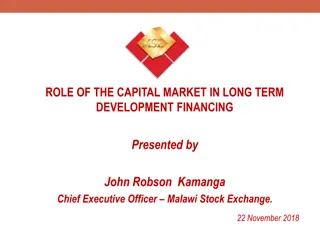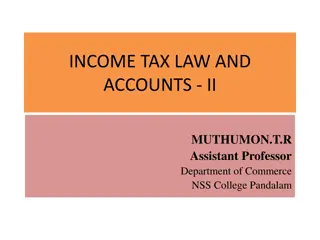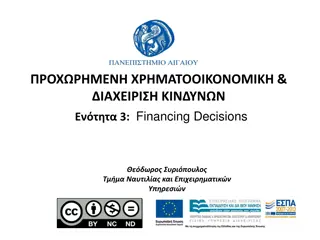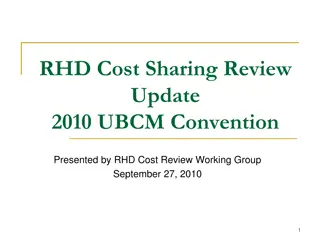
Project Cash Flows and Capital Budgeting Techniques
Learn about project cash flows and capital budgeting techniques in investment decision-making. Explore concepts like initial investments, annual expenses, cash flow equivalence methods, and evaluation techniques such as payback period and internal rate of return (IRR).
Download Presentation

Please find below an Image/Link to download the presentation.
The content on the website is provided AS IS for your information and personal use only. It may not be sold, licensed, or shared on other websites without obtaining consent from the author. If you encounter any issues during the download, it is possible that the publisher has removed the file from their server.
You are allowed to download the files provided on this website for personal or commercial use, subject to the condition that they are used lawfully. All files are the property of their respective owners.
The content on the website is provided AS IS for your information and personal use only. It may not be sold, licensed, or shared on other websites without obtaining consent from the author.
E N D
Presentation Transcript
Lecture 9 (chapter 5) SEPPA 09 Aug 2016 4/13/2025 1
Project Cash flows In most of the investment decision problems, we usually make an initial investment at the beginning of the project. Then this investment will make a series of cash benefits over a period of future years. The representation of future earnings along with the initial capital expenditure and annual expenses such as wages, raw material costs, operating costs, maintenance costs, and income taxes is called the project cash flows. 4/13/2025 2
Capital Budgeting Techniques With the background of knowledge of interest rate and time value of money, we can evaluate whether a project is feasible or not on the basis of cash flow equivalence methods. These techniques are also called Project Evaluation Techniques in finance. 4/13/2025 3
Capital Budgeting Techniques We can evaluate a project or select a project from different alternatives by the following methods: the equivalent present value (worth) method the equivalent future value (worth) method the equivalent annual value (worth) method. Apart from the above, we can evaluate a project on the basis of Internal Rate of Return (IRR) and the payback period. 4/13/2025 4
Payback Period Method The payback period is the number of years required to recover the investment made in a project. Example: Initial Investment = Rs 300,000 Annual Net benefits = Rs 75,000 Payback period = Initial investment/ Unif. Annual benefit =4 years 4/13/2025 5
Payback Period Method Benefits & flaws of Payback period method Benefit: simplicity Flaws: failure to measure profitability of project & no time value of money consideration 4/13/2025 6
Discounted Payback Period To modify the payback period method, we may consider the cost of fund (interest) used to support the project. This modified method is called discounted payback period. 4/13/2025 7
Present Value Analysis Until 1950s, the payback period method was widely used as a means of making investment decisions. As there are flaws in this method, businessmen began to search methods for improving the project evaluations. This led to the development of discounted cash flow (DCF) techniques, which take account of time value of money. One of the DCF methods is Net Present Value (NPV) method. Under NPV method, PV of all cash inflows are compared with PV of all cash outflows. The difference between these PV's is called Net Present Value (NPV). 4/13/2025 8
NPV Criterion The basic procedure for applying this criterion: Determine the required rate of interest the firm wants. This interest rate is called required rate of return (ROR) or minimum attractive rate of return (MARR). Estimate the service life of the project Estimate the cash inflow for each period of the service life Estimate the cash outflow for each period of service life Determine the net cash flows Find the present value of each net cash flow discounted at the MARR. Add up the PV's including the initial investment. Their sum is defined as the NPV of the project 4/13/2025 9
NPV Analysis NPV = A0/(1+i)0 + A1/(1+i)1 + A2/(1+i) 2 + .. +An/(1+i)n n ( / ) r 1 n n ) = + 1 1 ( / i NPV NPV A r n = + A i If NPV > 0, accept the investment If NPV = 0, remain indifferent If NPV< 0, reject the investment. 1 n 1 = ( / , , ) NPV A P F r n i 4/13/2025 10
NPV Analysis Examples Example 1: If a project's initial investment is Rs 300,000 and gives an equal annual savings of Rs 75,000. If the company wants MARR of 15%, determine the NPV of the project. Example 2 Tiger Machine Tool Company is considering the proposed acquisition of a new metal-cutting machine. The required initial investment of Rs 750,000 and the projected cash benefits for three years are as follows: The MARR is 15%. 4/13/2025 11
Example 2 End of year Cash flow 0 -Rs 750,000 1 244,000 2 273,400 3 557,600 4/13/2025 12
Assignments Do done examples chapter 5, 6, 7 & 8. (Chan S. Park,2007. Contemporary Engineering Economics) 4/13/2025 13







